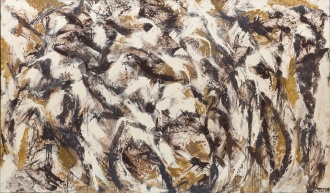This is the last article you can read this month
You can read more article this month
You can read more articles this month
Sorry your limit is up for this month
Reset on:
Please help support the Morning Star by subscribing here
Lee Krasner: Living Colour
Barbican, London
THE CHILD of Russian immigrants to New York, Lee Krasner (1908-84) bucked the traditional expectations of her stultifyingly strict Orthodox Jewish upbringing, by announcing her decision to become an artist at the age of just 14.
Having persuaded her reluctant family, she studied in various prestigious New York art schools intermittently over many years.

In her Self-Portrait of 1928 a serious young woman defiantly returns our gaze. Painted from life in her family’s Long Island garden, it shows her to be an accomplished young painter in the open-air tradition then widely taught worldwide by art academies, though several academic life drawings are anatomically correct but rather heavy-handed and uninspired.
Krasner’s first breakthrough came much later in 1937 at the modernist Hans Hofmann’s school, where he taught in a Cubist manner.
Her large charcoal drawings convincingly combine the ever-changing viewpoints of the act of seeing with the decisive, strong diagonals and implied movement which herald her mature paintings.
She recalled that she had “two major upheavals in her art life, breaking from the Academy into Cubism and meeting Jackson Pollock.” For better or worse, marrying him in 1945 would define her for decades.
In the post-war era Pollock was an acknowledged leader of the US avant garde, then being trumpeted in the Western world as the most important “advanced art.” It was covertly aided by the CIA as a cultural cold war weapon to denigrate Soviet socialist realism.
Marrying Pollock placed Krasner at the epicentre of the vibrant New York avant garde. But, as she later remarked, “even if I was not personally dominated by Pollock the whole art world was.”
Like many a male artists’ female partners, she got to paint in a bedroom while he had the large studio. Her Little Images of 1946-7 are small, highly controlled and strongly structured abstractions, with a sense of movement and love of vivid colour.
They have the all-over compositions pioneered by Pollock but, unlike the spontaneity and wildness of his first drip paintings of those years, Krasner’s convey a sense of restriction and fear of spontaneity.
But by the mid-1950s she produced more joyful and liberated collages, arguably her best work. Tearing and cutting shapes freed her from the laborious, overworked brushwork of her previous canvases.
The larger scale and clear shapes of Blue Level and Desert Moon of 1955 brought out her strengths by combining the decisiveness of her Cubist drawings and her fearless colour combinations, to create stimulating spatial ambiguities with bold, controlled dynamic forms.
In 1956 she was alone in Paris when told that Pollock had killed himself in a car crash. She soon moved to his large studio to paint on the same massive scale as he and other Abstract Expressionists.
This did not particularly improve her work. Decades of pent-up anger and inner turmoil spill out in thinly painted sweeping gestures across massive canvases, which express univalent, personal emotions, so leaving limited lasting resonances.
Her late works returned to the clearer shapes and calmer forms of her mid-1950s collages but on the massive scale of Hard-Edge art then favoured by corporate boardrooms.
Krasner was a self-assured, courageous artist with a strong sense of colour and movement. Her career undoubtedly suffered from the rampant sexism of the postwar decades which marginalised or ignored female artists.
But the content of her work was essentially a purely autobiographical vehicle for externalising her moods and feelings, so that the degree to which this narrow subject is of value to the wider public is debatable.
In its effort to rectify that sexist era’s undoubted injustices, the Barbican’s large retrospective over-inflates Krasner’s contribution to 20th-century art.
Its questionable claims that she was “one of the pioneers of Abstract Expressionism” and one of the first entirely abstract New York artists are difficult to substantiate.
Nor was she an extreme victim of art-world sexism, having had 10 solo exhibitions between 1950 to 1969 at a time when many female artists craved even a single one.
Krasner was fairly well known, albeit as Pollock’s wife. Recognising his importance, she nurtured his career with the worldliness which he lacked and guarded his legacy and estate after his death.
By taking a biographical stance, the exhibition celebrates Krasner as an outstanding and neglected artist, whereas she was simply one of many good ones.
Feminist art history since the 1970s has done fundamental, essential and invaluable work in discovering and rehabilitating many worthwhile female artists.
But the current zeitgeist stimulates a careerist art history which seeks out women artists simply for their sex and critically over-evaluates their work while stressing their victimhood.
While lucrative for the art market, it ultimately does a disservice to all female artists.
Runs until September 1, box office: barbican.org.uk.












